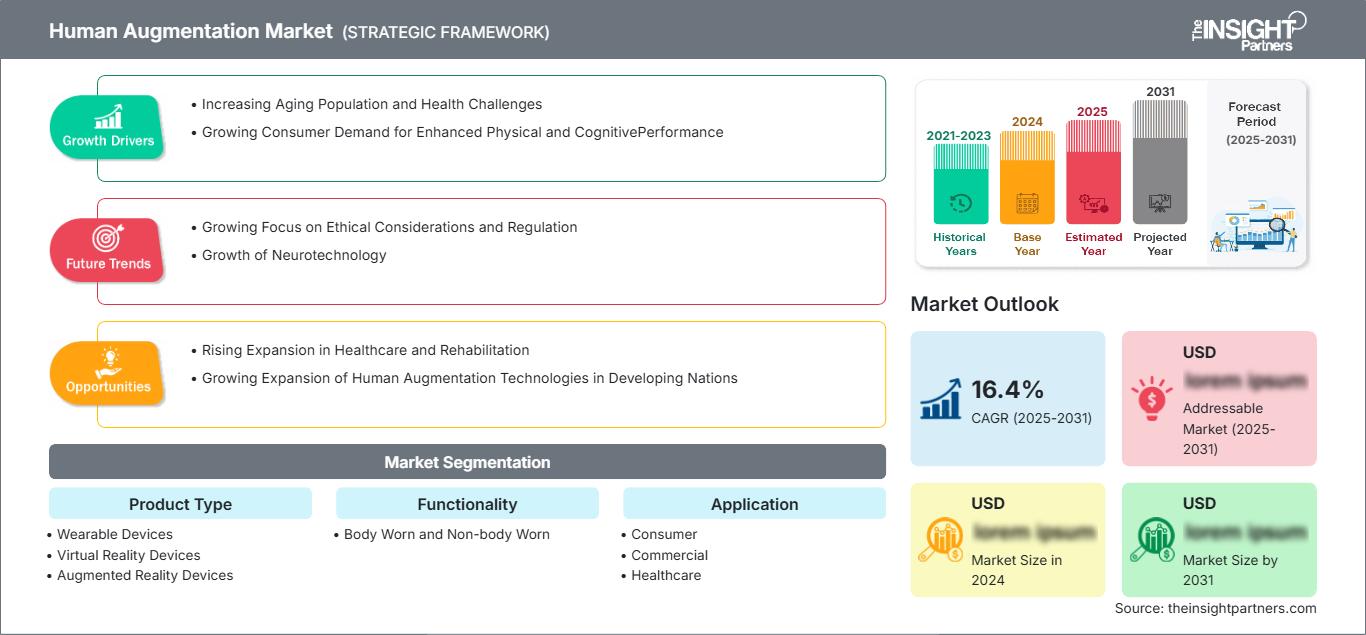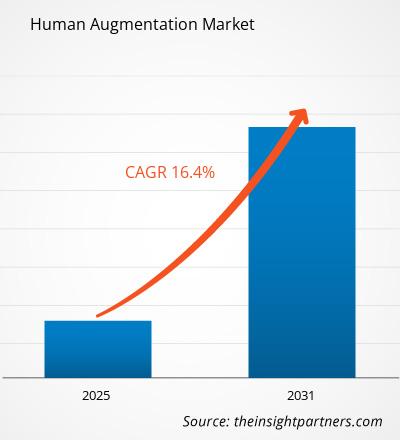The Human Augmentation Market is expected to register a CAGR of 16.4% from 2025 to 2031, with a market size expanding from US$ XX million in 2024 to US$ XX Million by 2031.
The report is segmented by Product Type (Wearable Devices, Virtual Reality Devices, Augmented Reality Devices, Exoskeleton, and Intelligent Virtual Assistants), Functionality (Body Worn and Non-body Worn), Application (Consumer, Commercial, Healthcare, Aerospace and Defense, Energy and Utility, and Others). The global analysis is further broken-down at regional level and major countries. The Report Offers the Value in USD for the above analysis and segments.
Purpose of the Report
The report Human Augmentation Market by The Insight Partners aims to describe the present landscape and future growth, top driving factors, challenges, and opportunities. This will provide insights to various business stakeholders, such as:
- Technology Providers/Manufacturers: To understand the evolving market dynamics and know the potential growth opportunities, enabling them to make informed strategic decisions.
- Investors: To conduct a comprehensive trend analysis regarding the market growth rate, market financial projections, and opportunities that exist across the value chain.
- Regulatory bodies: To regulate policies and police activities in the market with the aim of minimizing abuse, preserving investor trust and confidence, and upholding the integrity and stability of the market.
Human Augmentation Market Segmentation
Product Type
- Wearable Devices
- Virtual Reality Devices
- Augmented Reality Devices
- Exoskeleton
- Intelligent Virtual Assistants
Functionality
- Body Worn and Non-body Worn
Application
- Consumer
- Commercial
- Healthcare
- Aerospace and Defense
- Energy and Utility
- Others
Geography
- North America
- Europe
- Asia-Pacific
- South and Central America
- Middle East and Africa
You will get customization on any report - free of charge - including parts of this report, or country-level analysis, Excel Data pack, as well as avail great offers and discounts for start-ups & universities
Human Augmentation Market: Strategic Insights

-
Get Top Key Market Trends of this report.This FREE sample will include data analysis, ranging from market trends to estimates and forecasts.
Human Augmentation Market Growth Drivers
- Increasing Aging Population and Health Challenges: The increasing aging population worldwide is a major driver for the human augmentation market. As individuals age, they often face various health challenges that can hinder mobility and overall quality of life. Human augmentation technologies, such as prosthetics and mobility aids, can greatly improve the independence and well-being of elderly individuals. Additionally, as the prevalence of chronic diseases rises, the demand for solutions that can enhance physical capabilities and support rehabilitation is expected to grow, further propelling the market.
- Growing Consumer Demand for Enhanced Physical and CognitivePerformance: There is a growing consumer demand for products that enhance physical and cognitive performance, driven by a culture that increasingly values personal productivity and efficiency. From athletes seeking performance-enhancing gear to professionals aiming for cognitive enhancers, the market for human augmentation is expanding. This demand has led to innovations in wearable tech, smart devices, and even neuro-enhancement products that promise to boost various aspects of human ability. As consumers continue to seek ways to optimize their performance, the human augmentation market will continue to thrive.
Human Augmentation Market Future Trends
- Growing Focus on Ethical Considerations and Regulation: As the human augmentation market grows, there is an increasing focus on ethical considerations and regulations surrounding these technologies. Concerns about equity, privacy, and potential misuse of augmentation technologies are prompting discussions among stakeholders, including policymakers, technologists, and ethicists. This trend is leading to the development of guidelines and frameworks that aim to balance innovation with ethical practices. Companies that prioritize ethical development and transparency may find a competitive advantage in a market that values responsible innovation.
- Growth of Neurotechnology: The field of neurotechnology is rapidly evolving and is becoming a significant trend within the human augmentation market. Technologies that interface directly with the nervous system, such as brain-computer interfaces (BCIs), are gaining attention for their potential to enhance cognitive abilities and restore lost functions. Applications range from assisting individuals with disabilities to improving mental performance in healthy individuals. As research and development in neurotechnology progress, more applications are expected to emerge, leading to new opportunities for growth in this sector.
Human Augmentation Market Opportunities
- Rising Expansion in Healthcare and Rehabilitation: The human augmentation market presents substantial opportunities in the healthcare and rehabilitation sectors. Technologies that enhance mobility, such as robotic exoskeletons and advanced prosthetics, can significantly improve patient outcomes and quality of life. Moreover, innovations in cognitive augmentation can aid in rehabilitation for stroke victims or individuals with brain injuries. As healthcare systems increasingly adopt personalized and technology-driven approaches to treatment, the demand for human augmentation solutions in these areas is likely to expand.
- Growing Expansion of Human Augmentation Technologies in Developing Nations: There is a growing opportunity for human augmentation technologies in emerging markets, where rising disposable incomes and urbanization are driving demand for advanced solutions. As these regions develop, there is an increasing need for technologies that enhance productivity and address health challenges. Additionally, younger demographics in these markets are more open to adopting innovative technologies, creating a ripe environment for human augmentation products. Companies that strategically position themselves in these emerging markets stand to benefit significantly.
Human Augmentation Market Regional Insights
The regional trends and factors influencing the Human Augmentation Market throughout the forecast period have been thoroughly explained by the analysts at The Insight Partners. This section also discusses Human Augmentation Market segments and geography across North America, Europe, Asia Pacific, Middle East and Africa, and South and Central America.
Human Augmentation Market Report Scope
| Report Attribute | Details |
|---|---|
| Market size in 2024 | US$ XX million |
| Market Size by 2031 | US$ XX Million |
| Global CAGR (2025 - 2031) | 16.4% |
| Historical Data | 2021-2023 |
| Forecast period | 2025-2031 |
| Segments Covered |
By Product Type
|
| Regions and Countries Covered |
North America
|
| Market leaders and key company profiles |
|
Human Augmentation Market Players Density: Understanding Its Impact on Business Dynamics
The Human Augmentation Market is growing rapidly, driven by increasing end-user demand due to factors such as evolving consumer preferences, technological advancements, and greater awareness of the product's benefits. As demand rises, businesses are expanding their offerings, innovating to meet consumer needs, and capitalizing on emerging trends, which further fuels market growth.

- Get the Human Augmentation Market top key players overview
Key Selling Points
- Comprehensive Coverage: The report comprehensively covers the analysis of products, services, types, and end users of the Human Augmentation Market, providing a holistic landscape.
- Expert Analysis: The report is compiled based on the in-depth understanding of industry experts and analysts.
- Up-to-date Information: The report assures business relevance due to its coverage of recent information and data trends.
- Customization Options: This report can be customized to cater to specific client requirements and suit the business strategies aptly.
The research report on the Human Augmentation Market can, therefore, help spearhead the trail of decoding and understanding the industry scenario and growth prospects. Although there can be a few valid concerns, the overall benefits of this report tend to outweigh the disadvantages.
Frequently Asked Questions
What are the options available for the customization of this report?
What are the deliverable formats of the Human Augmentation market report?
What are the future trends of the Human Augmentation market?
What are the driving factors impacting the Human Augmentation market?
What is the expected CAGR of the Human Augmentation market?
-
- Historical Analysis (2 Years), Base Year, Forecast (7 Years) with CAGR
- PEST and SWOT Analysis
- Market Size Value / Volume - Global, Regional, Country
- Industry and Competitive Landscape
- Excel Dataset
Recent Reports
Testimonials
Reason to Buy
- Informed Decision-Making
- Understanding Market Dynamics
- Competitive Analysis
- Identifying Emerging Markets
- Customer Insights
- Market Forecasts
- Risk Mitigation
- Boosting Operational Efficiency
- Strategic Planning
- Investment Justification
- Tracking Industry Innovations
- Aligning with Regulatory Trends





















 Get Free Sample For
Get Free Sample For